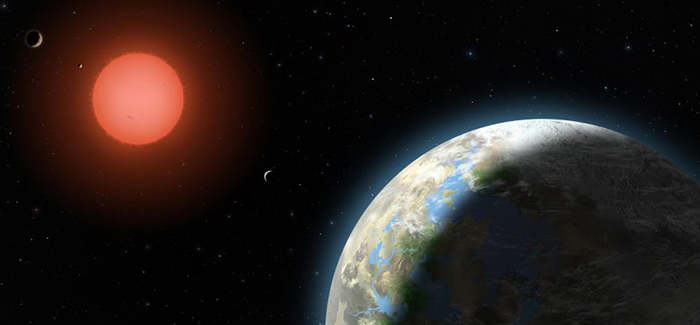
A planet with clouds and surface water orbits a red dwarf star in this artist’s conception of the Gliese 581 star system. New findings from the University of Chicago and Northwestern University show that planets orbiting red dwarf stars are more likely to be habitable than previously believed. (University of Chicago News Office)
Many more planets than previously known appear to have conditions that are just right for life.
The “Goldilocks” habitable zone around each star—the narrow sweet spot where a planet’s temperature and heat retention are just right to maintain surface water—is growing up. UChicago geophysicists Jun Yang and Dorian Abbot, working with Northwestern researcher Nicolas Cowan, simulated cloud behavior on Earth-sized planets toward the inner edge of the habitable zones around red dwarf stars, and found that 50 to 100 percent more had the potential for life when the water clouds’ effects on climate were accounted for.
Previously, investigations had used limited one-dimensional convection models, or had discounted planets considered too close to their stars to be cool enough for life. Instead, Yang, Abbot, and Cowan used 216 networked computers over several months to perform three-dimensional global simulations with myriad intricate variables. They calculated that planets in tight orbits become tidally locked: the same hemisphere always faces the sun, and what’s called the substellar point is always directly beneath the sun.
On tidally locked planets with surface water, about 60 percent of this substellar region is covered by high-level clouds, and about 80 percent by low-level clouds. In the representative case shown above, this near-constant cloud cover provided a mean cooling of 73 kelvin on the planet’s surface—roughly the difference between summer in Death Valley and in Antarctica. Below are the researchers’ maps of how adding clouds to their simulations reduced the surface temperature, humidity, and thermal emissions on a representative, tidally locked terrestrial planet, where the substellar point is the black dot.
These findings will undergo a reality check when the James Webb Space Telescope launches in 2018 and measures the temperature on such tidally locked planets. According to Yang, Abbot, and Cowan, tidally locked planets with extensive cloud cover will appear cooler on their dayside than their nightside—without cloud cover, it would be the opposite—providing heavy evidence for liquid surface water.
[[{"type":"media","view_mode":"media_original","fid":"916","attributes":{"alt":"","class":"media-image","height":"337","typeof":"foaf:Image","width":"460"}}]]
Graphic courtesy Jun Yang, Dorian Abbot, and Nicholas Cowan; adapted by Joy Olivia Miller.
Infographic

Geophysicists simulated cloud behavior on Earth-sized planets toward the inner edge of the habitable zones around red dwarf stars.
